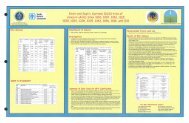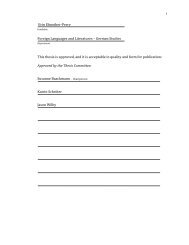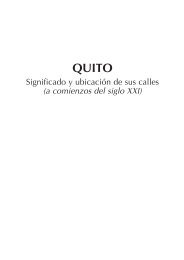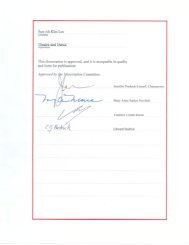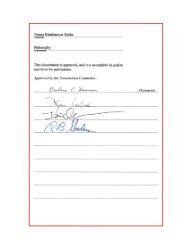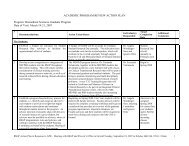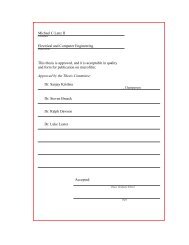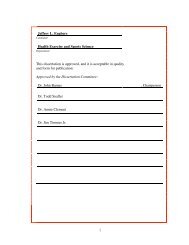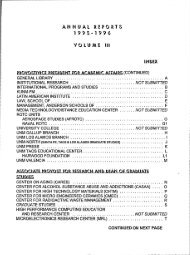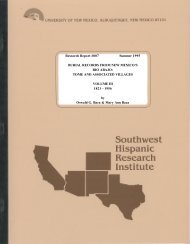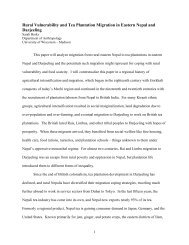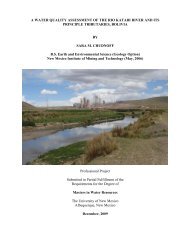Anil Reddy Geeda Electrical and Computer Engineering This thesis ...
Anil Reddy Geeda Electrical and Computer Engineering This thesis ...
Anil Reddy Geeda Electrical and Computer Engineering This thesis ...
You also want an ePaper? Increase the reach of your titles
YUMPU automatically turns print PDFs into web optimized ePapers that Google loves.
<strong>Anil</strong> <strong>Reddy</strong> <strong>Geeda</strong><br />
C<strong>and</strong>idate<br />
<strong>Electrical</strong> <strong>and</strong> <strong>Computer</strong> <strong>Engineering</strong><br />
Department<br />
<strong>This</strong> <strong>thesis</strong> is approved, <strong>and</strong> it is acceptable in quality <strong>and</strong> form for publication:<br />
Approved by the Thesis Committee:<br />
Dr. Vince D. Calhoun , Chairperson<br />
Dr. Julia M. Stephen<br />
Dr. Nasir Ghani<br />
i
FREQUENCY SPECIFIC DEFICITS IN SCHIZOPHRENIA<br />
by<br />
ANIL REDDY GEEDA<br />
BACHELOR OF TECHNOLOGY IN ELECTRONICS<br />
AND<br />
COMMUNICATION ENGINEERING<br />
2009<br />
THESIS<br />
Submitted in Partial Fulfillment of the<br />
Requirements for the Degree of<br />
Master of Science<br />
<strong>Computer</strong> <strong>Engineering</strong><br />
The University of New Mexico<br />
Albuquerque, New Mexico<br />
DECEMBER, 2011<br />
ii
ACKNOWLEDGEMENT<br />
Firstly, I am very much indebted to Dr. Julia M. Stephen <strong>and</strong> Dr. Vince D. Calhoun for<br />
providing me with motivation <strong>and</strong> encouragement throughout the course of my work.<br />
Their breadth of knowledge <strong>and</strong> enthusiasm has been invaluable. Without their<br />
supervision <strong>and</strong> guidance, I would not be able to complete my <strong>thesis</strong>.<br />
I would also like to thank Tongsheng Zhang <strong>and</strong> Brian Coffman for their valuable<br />
suggestions <strong>and</strong> for the many intuitive discussions we had.<br />
I am also thankful to Dr. Nasir Ghani for his encouragement <strong>and</strong> support.<br />
I am highly indebted to my Father, Ramana <strong>Reddy</strong> <strong>Geeda</strong> <strong>and</strong> my mother, Vanaja <strong>Geeda</strong><br />
for their affection, motivation <strong>and</strong> encouragement to pursue a Master’s degree.<br />
iii
FREQUENCY SPECIFIC DEFICITS IN SCHIZOPHRENIA<br />
by<br />
<strong>Anil</strong> <strong>Reddy</strong> <strong>Geeda</strong><br />
B.TECH., Electronics <strong>and</strong> Communication <strong>Engineering</strong>, VIT University, 2009<br />
M.S., <strong>Computer</strong> <strong>Engineering</strong>, University of New Mexico 2011<br />
ABSTRACT<br />
Coherence estimation is one of the methods for underst<strong>and</strong>ing functional connectivity<br />
deficits <strong>and</strong> frequency specific deficits in schizophrenia. Coherence between different<br />
lobes of the brain from task related data at different frequency b<strong>and</strong>s was investigated in<br />
patients with Schizophrenia (SP) <strong>and</strong> Healthy Normal Volunteers (HNV). The task was<br />
aimed to study the neural mechanisms underlying auditory <strong>and</strong> visual integration in<br />
patients with schizophrenia relative to healthy controls, which requires intact connectivity<br />
between the lobes of the brain in order to recombine the sensory information into a<br />
complete percept of the external world. Coherence was calculated from the processed<br />
magneto-encephalography (MEG) data for each pair of lobes of left temporal <strong>and</strong><br />
parietal, left temporal <strong>and</strong> occipital, right temporal <strong>and</strong> parietal, right temporal <strong>and</strong><br />
occipital, parietal <strong>and</strong> occipital at the frequency b<strong>and</strong>s of delta (0 to 4 Hz), theta (4 -8<br />
Hz), alpha (8-13 Hz), beta (13 -30 Hz) <strong>and</strong> gamma (30-100 Hz).<br />
Analysis Of Variance (ANOVA) was performed on the coherence data of 30 subjects<br />
comprised of 15 patients <strong>and</strong> 15 controls. There was a significant interaction between<br />
iv
frequency <strong>and</strong> diagnosis with age. Significant differences were found between patients<br />
<strong>and</strong> controls at the Delta frequency b<strong>and</strong>, which was confirmed with Bonferroni-<br />
corrected -t-tests at the delta frequency range in each pair of regions. It was found that<br />
patients had higher coherence than controls in the delta frequency b<strong>and</strong> <strong>and</strong> it was<br />
significant across lobes which suggest an abnormal MEG coherence during evoked<br />
activity in schizophrenic patients.<br />
v
TABLE OF CONTENTS<br />
LIST OF FIGURES ……………………………………………………….. vii<br />
LIST OF TABLES ………………………………………………………... x<br />
LIST OF ABBREVIATIONS AND ACRONYMS ……………………… xi<br />
1 INTRODUCTION ………………………………………………………. 1<br />
1.1 Magneto-encephalography (MEG) ………………………. 3<br />
1.2 EEG <strong>and</strong> MEG Coherence ……………………………... 4<br />
1.3 Frequency B<strong>and</strong>s ………………………………………… 5<br />
2 BACKGROUND ……………………………………………………… 7<br />
2.1 Frequency Specific Deficits ……………………………… 7<br />
2.2 Brain Lobes ………………………………………………. 9<br />
2.3 Task Description ………………………………………… 10<br />
2.4 Data processing …………………………………………... 13<br />
3 COHERENCE METHODOLOGY ……………………………………... 16<br />
3.1 Coherence Methodology …………………………………. 16<br />
4 RESULTS ……………………………………………………………….. 19<br />
Results ……………………………………………………. 25<br />
vi
5 CONCLUSION …………………………………………………………. 26<br />
5.1 Conclusion …………………………………………………26<br />
5.2 Future Work ………………………………………………..28<br />
APPENDIX …………………………………………………………….. …29<br />
REFERENCES …………………………………………………………….33<br />
vii
LIST OF FIGURES<br />
Figure 1: MEG System …………………………………………………….. 1<br />
Figure 2: Different Lobes of the brain ……………………………………… 9<br />
Figure 3: Background perspective of A Near <strong>and</strong> A Far …………………… 11<br />
Figure 4: Background perspective of V Near <strong>and</strong> AV Near ………………. 12<br />
Figure 5: Background perspective of V Far <strong>and</strong> AV Far ………………….. 12<br />
Figure 6: Left Temporal to Parietal Lobe Coherence - AV Near ………………... 19<br />
Figure 7: Right Temporal to Parietal Lobe Coherence - AV Near ……………...... 19<br />
Figure 8: Parietal to Occipital Lobe Coherence - AV Near ……………………….. 19<br />
Figure 9: Left Temporal to Occipital Lobe Coherence - AV Near ………………... 19<br />
Figure 10: Right Temporal to Occipital Lobe Coherence - AV Near ……………. 19<br />
Figure 11: Left Temporal to Parietal Lobe Coherence - AV Far ………………… 20<br />
Figure 12: Right Temporal to Parietal Lobe Coherence - AV Far ……………...... 20<br />
Figure 13: Parietal to Occipital Lobe Coherence - AV Far ……………………….. 20<br />
Figure 14: Left Temporal to Occipital Lobe Coherence - AV Far ………………… 20<br />
Figure 15: Right Temporal to Occipital Lobe Coherence - AV Far ……………… 20<br />
Figure 16: Left Temporal to Parietal Lobe Coherence - V Near ………………… 21<br />
viii
Figure 17: Right Temporal to Parietal Lobe Coherence - V Near ……………...... 21<br />
Figure 18: Parietal to Occipital Lobe Coherence - V Near ………………………... 21<br />
Figure 19: Left Temporal to Occipital Lobe Coherence - V Near ………………… 21<br />
Figure 20: Right Temporal to Occipital Lobe Coherence - V Near ……………… 21<br />
Figure 21: Left Temporal to Parietal Lobe Coherence - V Far ………………….. 22<br />
Figure 22: Right Temporal to Parietal Lobe Coherence - V Far ……………......... 22<br />
Figure 23: Parietal to Occipital Lobe Coherence - V Far …………………………. 22<br />
Figure 24: Left Temporal to Occipital Lobe Coherence - V Far ………………….. 22<br />
Figure 25: Right Temporal to Occipital Lobe Coherence - V Far ……………….. 22<br />
Figure 26: Left Temporal to Parietal Lobe Coherence - A Near ………………… 23<br />
Figure 27: Right Temporal to Parietal Lobe Coherence - A Near ……………...... 23<br />
Figure 28: Parietal to Occipital Lobe Coherence - A Near ………………………... 23<br />
Figure 29: Left Temporal to Occipital Lobe Coherence - A Near ………………… 23<br />
Figure 30: Right Temporal to Occipital Lobe Coherence - A Near ……………... 23<br />
Figure 31: Left Temporal to Parietal Lobe Coherence - A Far ………………….. 24<br />
Figure 32: Right Temporal to Parietal Lobe Coherence - A Far ……………......... 24<br />
Figure 33: Parietal to Occipital Lobe Coherence - A Far ………………………….. 24<br />
ix
Figure 34: Left Temporal to Occipital Lobe Coherence - A Far ………………….. 24<br />
Figure 35: Right Temporal to Occipital Lobe Coherence - A Far ………………. 24<br />
Figure 36: Mean coherence across conditions <strong>and</strong> regions at each frequency ……. 25<br />
x
LIST OF TABLES<br />
Table 1: Frequency Ranges ………………………………………………………… 4<br />
Table 2: Mean age <strong>and</strong> st<strong>and</strong>ard deviations of patients <strong>and</strong> controls ………………..15<br />
Table 3: Mean Olanzapine equivalent of patients ……………………………………15<br />
xi
LIST OF ABBREVIATIONS AND ACRONYMS<br />
fMRI Functional Magnetic Resonance Imaging<br />
ICA Independent Component Analysis<br />
ROI Region of Interest<br />
EEG Electroencephalography<br />
MEG Magnetoencephalography<br />
PS Photic Simulation<br />
COBRE Center of Biomedical Research Excellence<br />
SP Schizophrenia Patients<br />
HNV Healthy Normal Volunteers<br />
AV Auditory-Visual<br />
A Auditory<br />
V Visual<br />
FIFF Functional Image File Format<br />
MRI Magnetic Resonance Imaging<br />
ANOVA Analysis of Variance<br />
xii
FFT Fast Fourier Transform<br />
xiii
Chapter 1<br />
INTRODUCTION<br />
Schizophrenia is a neuro-developmental disorder involving abnormal connections<br />
between cortical regions in the brain. Abnormality in these connections leads to<br />
misconnections in many aspects of mental activity <strong>and</strong> hinders the coordination of motor<br />
<strong>and</strong> mental activity. Schizophrenia is a cognitive disturbance <strong>and</strong> a cognitive deficit that<br />
arises from the abnormalities in neural circuits <strong>and</strong> is defined by the more fundamental<br />
disruption in mental processes occurring as a consequence of a disruption in neural<br />
circuitry. Thought disorder is the primary defining feature of schizophrenia <strong>and</strong> exhibits<br />
symptoms that represent abnormalities in almost all aspects of human mental activity like<br />
inferential thinking, perception, language, motor <strong>and</strong> social behavior, volition, emotional<br />
expression <strong>and</strong> hedonic capacity etc. [ Nancy C. Andreasen, 1999].<br />
Connectivity deficits between various regions of the brain play a major role in the<br />
pathophysiology of schizophrenia. A functional magnetic resonance imaging (fMRI)<br />
study of schizophrenia using independent component analysis (ICA) identified some<br />
networks of the brain which were found to be implicated in schizophrenia during the<br />
auditory oddball paradigm. The results of this study indicated that patients with<br />
schizophrenia had functional connectivity differences in networks related to auditory<br />
processing, executive control <strong>and</strong> baseline functional activity <strong>and</strong> also suggested that<br />
1
cognitive deficits associated with schizophrenia are widespread <strong>and</strong> that a functional<br />
connectivity approach can help underst<strong>and</strong> it better [Dae ll Kim et al., 2009.]<br />
Functional Connectivity is defined as the temporal correlation between<br />
neurophysiological measurements made in different brain areas. So a pair of regions is<br />
considered functionally connected if their activity is in some way correlated. Functional<br />
connectivity is caused by the common influence of some external event on distant neural<br />
areas <strong>and</strong> it does not comment on how the correlations between those areas are mediated<br />
[Friston et al, 1993].<br />
Coherence is one of the methods for measuring functional connectivity. One<br />
characteristic of coherence is that it is insensitive to phase variability across measured<br />
time series. In an event-related study, coherence was used to measure the functional<br />
connectivity between remote brain regions. It was proposed that coherence was more<br />
suitable when phase difference varied largely across brain regions as coherence is less<br />
sensitive to such variability. The researchers of this study applied coherence <strong>and</strong> partial<br />
coherence analyses to functional magnetic resonance imaging (fMRI) data to measure<br />
task-related functional interactions between neural regions <strong>and</strong> used this to generate maps<br />
of task-specific connectivity associated with seed regions of interest (ROIs). In turn these<br />
were compared across tasks, revealing nodes with task-related changes of connectivity to<br />
the seed ROI (Sun et al., 2004).<br />
A Functional Magnetic Resonance Imaging (fMRI) study of the functional connectivity<br />
throughout the entire brain in schizophrenia found decreased functional connectivity in<br />
schizophrenia during rest <strong>and</strong> also reported that such abnormalities were widely<br />
2
distributed throughout the entire brain rather than restricted to a few specific brain<br />
regions. These results strongly supported that schizophrenia may arise from the disrupted<br />
functional integration of widespread brain areas [ Meng Liang, Yuan Zhou, et al, 2005].<br />
1.1 Magnetoencephalography (MEG)<br />
Magnetoencephalography is a technique for mapping brain activity by recording the<br />
magnetic fields produced by the small intra-cellular electrical currents in the neurons of<br />
the brain.<br />
Fig 1: MEG System.<br />
Image source:<br />
http://www.unitn.it/en/cimec/10906/magnetoencephalography-lab<br />
MEG is a direct measure of brain activity since it<br />
measures the intracellular currents in the neurons.<br />
Sensory information sent to the brain causes a<br />
nerve impulse which results in an action potential<br />
<strong>and</strong> this action potential causes a small current in<br />
the neurons which produces the magnetic fields.<br />
The MEG sensors detect these magnetic fields<br />
thus recording the brain activity.<br />
These sensors are made of Super Conducting Quantum Interference Devices called<br />
SQUIDS which are extremely sensitive to magnetic fields <strong>and</strong> thus will be able to detect<br />
the very weak magnetic fields produced by the intracellular currents in the neurons of the<br />
3
ain. SQUIDS need to be operated at cryogenic temperatures for detection of the weaker<br />
magnetic fields <strong>and</strong> so the SQUIDS are placed in a helmet shaped liquid helium<br />
containing vessel called Dewar. To minimize the interference from external magnetic<br />
disturbances along with the earth’s magnetic field, noise generated by the electrical<br />
equipment, radiofrequency signals, <strong>and</strong> low frequency magnetic fields produced by<br />
moving objects, the MEG system is operated in a shielded room. MEG has very high<br />
temporal resolution <strong>and</strong> events with timescales on the orders of milliseconds can be<br />
measured. It also has good spatial resolution on the orders of millimeters. MEG is non-<br />
invasive <strong>and</strong> non-hazardous. It does not require injection of isotopes, exposure to X-rays,<br />
<strong>and</strong> exposure to magnetic fields. So children <strong>and</strong> even infants can be studied using MEG<br />
[Hamalainen, et al,. 1993]<br />
1.2 EEG <strong>and</strong> MEG Coherence<br />
EEG coherence is often used to assess functional connectivity in human cortex. However,<br />
moderate to large EEG coherence can also arise simply by the volume conduction of<br />
current through the tissues of the head. Volume conduction can elevate EEG coherence at<br />
all frequencies for moderately separated (20 cm) electrodes. <strong>This</strong> volume conduction effect was<br />
readily observed in experimental EEG at high frequencies (40–50 Hz). Cortical sources<br />
generating spontaneous EEG in this b<strong>and</strong> are apparently uncorrelated. In contrast, lower<br />
frequency EEG coherence appears to result from a mixture of volume conduction effects<br />
<strong>and</strong> genuine source coherence. Surface Laplacian EEG methods help to minimize the<br />
effect of volume conduction on coherence estimates by emphasizing sources at smaller<br />
4
spatial scales than unprocessed potentials (EEG). MEG coherence estimates are also<br />
affected by the field spread across sources <strong>and</strong> sensors, however, MEG signals are not as<br />
affected by volume conduction as EEG. The type of MEG sensor influences the field<br />
spread differently with planar gradiometers limiting field spread more than axial<br />
gradiometers or magnetometers [ Ramesh Srinivasan et al,. 2007].<br />
1.3 Frequency B<strong>and</strong>s:<br />
Based on EEG studies, brain activity is often divided into 5 physiologically-based<br />
frequency b<strong>and</strong>s. Table 1: Frequency Ranges<br />
Type Frequency (Hz)<br />
Frequency1 - Delta Up to 4 Hz<br />
Frequency2 - Theta 4 - 8<br />
Frequency3 - Alpha 8 -13<br />
Frequency4 - Beta >13 - 30<br />
Frequency5 - Gamma 30 - 100+<br />
Source: Niedermeyer E. <strong>and</strong> Da Silva F.L. (2004). Electroencephalography: Basic Principles, Clinical<br />
Applications, <strong>and</strong> Related Fields. Lippincot Williams & Wilkins. ISBN 0781751268.<br />
5
Delta frequency b<strong>and</strong>: <strong>This</strong> frequency b<strong>and</strong> ranges from 0 to 4 Hz. The signals in this<br />
frequency have been found during tasks requiring continuous attention.<br />
Theta frequency b<strong>and</strong>: <strong>This</strong> frequency b<strong>and</strong> ranges from 4 to 8 Hz. The signals in this<br />
frequency have been found to rise in situations when a person is trying to hold back a<br />
response <strong>and</strong> also in lot of other situations.<br />
Alpha frequency b<strong>and</strong>: <strong>This</strong> frequency b<strong>and</strong> ranges from 8 to 13 Hz. The signals in this<br />
frequency range arise from occipital regions when eyes are closed <strong>and</strong> the person is alert<br />
<strong>and</strong> not sleeping. These also arise in different locations across the brain during inhibiting<br />
a timing activity.<br />
Beta frequency b<strong>and</strong>: <strong>This</strong> frequency b<strong>and</strong> ranges from >13 to 30 Hz. Signals in this<br />
frequency range are found when a person is cautious <strong>and</strong> alert working on something<br />
with immense concentration.<br />
Gamma frequency b<strong>and</strong>: <strong>This</strong> frequency b<strong>and</strong> ranges from 30 to above 100 Hz. <strong>This</strong><br />
frequency range has been implicated in stimulus component binding.<br />
6
2.1 Frequency Specific Deficits:<br />
CHAPTER 2<br />
BACKGROUND<br />
An EEG study conducted to examine intrahemispheric EEG coherence at rest <strong>and</strong> during<br />
photic stimulation (PS) in 18 drug-naïve patients with paranoid schizophrenia <strong>and</strong> 30<br />
control subjects reported that schizophrenic patients had significantly higher<br />
intrahemispheric coherence of the resting EEG for the delta b<strong>and</strong> compared to that of the<br />
controls. <strong>This</strong> study also reported that during photic stimulation, patients also had<br />
significantly higher EEG coherence over the left posterior regions. These results provided<br />
evidence that schizophrenic patients have abnormal EEG coherence in both resting <strong>and</strong><br />
stimulus conditions <strong>and</strong> suggested more diffuse, undifferentiated functional organization<br />
within hemispheres [ Yuji Wada et al,. 1998].<br />
Another EEG study with eyes closed in a resting state condition compared the coherence<br />
in 11 unmedicated schizophrenic patients (including 9 never medicated patients) <strong>and</strong> in<br />
15 normal controls <strong>and</strong> reported that interhemispheric coherence was higher in the<br />
patients with schizophrenia in the delta b<strong>and</strong>s in some specific areas of occipital <strong>and</strong><br />
temporal regions relative to controls [Yaseko Nagase et al, 1992].<br />
7
These findings provide evidence that schizophrenia patients have frequency specific<br />
deficits <strong>and</strong> have significant differences in the functional connectivity when compared to<br />
healthy controls.<br />
Coherence data were estimated from the COBRE project 2 for which my mentor Dr. Julia<br />
Stephen was the Principal Investigator. The goal of project 2 was to study the neural<br />
mechanisms underlying auditory <strong>and</strong> visual integration in patients with schizophrenia<br />
(SP) <strong>and</strong> healthy normal volunteers (HNV). My <strong>thesis</strong> project focused on functional<br />
connectivity by analyzing frequency specific deficits between various lobes using MEG<br />
coherence as the analysis approach using a task which was specifically designed to study<br />
auditory <strong>and</strong> visual integration in Schizophrenia which involves connectivity between<br />
various lobes. Since there are frequency specific deficits reported by researchers<br />
previously, I expected to find them between the coherence of Schizophrenics <strong>and</strong> normal<br />
controls while testing for functional connectivity between Left temporal-Parietal, Left<br />
temporal-Occipital, Parietal-Occipital, Right temporal-Parietal <strong>and</strong> Right temporal-<br />
Occipital in the delta b<strong>and</strong> frequency using a relatively new procedure of estimating the<br />
coherence described in following sections.<br />
8
2.2 Brain Lobes<br />
Figure 2: Different lobes of the brain<br />
Image by John A Beal, Louisiana State University, Health Sciences Center Shreveport<br />
Temporal Lobe:<br />
It is located on the bottom section of the brain. Primary auditory cortex which is<br />
responsible for interpreting sounds <strong>and</strong> language we hear is located in this lobe. <strong>This</strong> lobe<br />
is associated with perception <strong>and</strong> recognition of auditory stimuli, memory, <strong>and</strong> speech.<br />
Occipital Lobe:<br />
It is located at the back portion of the brain. Primary visual cortex, which receives <strong>and</strong><br />
interprets information from the retinas of the eyes, is located in this lobe. <strong>This</strong> lobe is<br />
associated with interpreting visual stimuli <strong>and</strong> information.<br />
9
Parietal Lobe:<br />
It is located in the middle section of the brain. Somato-sensory cortex which is essential<br />
to the processing of the body's senses is located in this lobe. <strong>This</strong> lobe is responsible for<br />
processing tactile sensory information such as pressure, touch, <strong>and</strong> pain. On the whole it<br />
is associated with movement, orientation, recognition <strong>and</strong> perception of stimuli.<br />
2.3 Task Description:<br />
The MEG data collected for this study was collected during an auditory <strong>and</strong> visual<br />
integration task using an ecologically relevant paradigm that simulates near <strong>and</strong> distant<br />
(far) static sources in a perspective drawing of a soccer field using both auditory <strong>and</strong><br />
visual stimuli. The stimuli are presented as auditory alone, visual alone, <strong>and</strong> combined<br />
auditory/visual conditions. The subjects must decide whether the stimuli are near or far<br />
with a button press. Coherence data were estimated for 6 stimulus conditions. They were<br />
S1 - AV Near (Auditory stimulus <strong>and</strong> Visual stimulus together with the Visual stimulus,<br />
a soccer ball appearing near to the subject), S2 - AV Far (Auditory stimulus <strong>and</strong> Visual<br />
stimulus together with the Visual stimulus, a soccer ball appearing far from the subject),<br />
S5 - V Near (Visual stimulus alone which is a soccer ball appearing near to the subject),<br />
S6 - V Far (Visual stimulus alone which is a soccer ball appearing far to the subject), S7 -<br />
A Near (Auditory stimulus alone, which sounds near to the subject) <strong>and</strong> S8 - A Far<br />
(Auditory stimulus alone, which sounds far from the subject).<br />
10
Figure 3: Background perspective drawing of the soccer<br />
field with goalie <strong>and</strong> net. Auditory only stimuli such as<br />
ANear <strong>and</strong> AFar were presented with this background.<br />
Figure 3 shows the back-ground perspective drawing of a soccer field with goalie <strong>and</strong> net<br />
presented for the Audio Near <strong>and</strong> Audio Far conditions. The background is presented<br />
with a brief soccer ball “bouncing” sound (~50 ms duration) with the Audio Near<br />
stimulus 6 dB louder than the Audio Far stimulus. The subjects have to decide with a<br />
button press whether the stimulus presented is near or far.<br />
11
Figure 4: <strong>This</strong> depicts the Near presentation of visual stimuli<br />
Vnear <strong>and</strong> also for AVNear along with the audio.<br />
Figure 4 shows the back-ground perspective drawing of a soccer field with goalie, net<br />
<strong>and</strong> a soccer ball (appearing near) presented for the Video Near <strong>and</strong> Audio-Video-Near<br />
conditions. The near <strong>and</strong> far AV stimuli were simulated by offsetting the auditory tone by<br />
5ms relative to the visual stimulus for both near <strong>and</strong> far conditions.<br />
Fig 5: FAR presentation of visual stimuli VFar. <strong>This</strong> is also<br />
shown for AVFar along with an audio. Participants were<br />
asked to maintain fixation on the goalie throughout the<br />
experiment.<br />
12
Figure 5 shows the background presented for the Video Far (soccer ball far) <strong>and</strong> Audio<br />
Video Far stimulus conditions.<br />
In the NEAR stimulus condition, the soccer ball appeared in the central foreground of the<br />
soccer field <strong>and</strong> occupied the participant’s lower central visual field (visual angle: 0.8◦,<br />
eccentricity: 7◦). In the FAR condition, the soccer ball was smaller <strong>and</strong> occupied the<br />
participant’s central visual field (visual angle: 0.3◦, eccentricity: 0.5◦). The auditory<br />
stimulus was a brief soccer ball “bouncing” sound (~50 ms duration) with the near<br />
stimulus 6 dB louder than the far stimulus. For the NEAR <strong>and</strong> FAR multisensory<br />
conditions, auditory <strong>and</strong> visual stimuli were presented together. All visual stimuli were<br />
presented on a computer monitor located 1 m from the participant. Auditory stimuli were<br />
presented binaurally through a set of ear inserts.<br />
Fifteen healthy normal volunteers (HNV) <strong>and</strong> fifteen schizophrenia patients (SP)<br />
participated in this study. All participants provided written informed consent, <strong>and</strong><br />
procedures were conducted in accordance with the st<strong>and</strong>ards of the Institutional Review<br />
Board of the University of New Mexico <strong>and</strong> the Declaration of Helsinki.<br />
2.4 Data Processing:<br />
MEG data were collected using the 306 channel MEG machine designed by Elekta<br />
Neuromag. Out of 306 channels, 204 channels are gradiometers <strong>and</strong> 102 channels are<br />
magnetometers. After the data collection, data was filtered using Max-filter, a tool<br />
designed by Elekta Neuromag to suppress magnetic interferences coming from inside <strong>and</strong><br />
outside of the sensor array, to reduce measurement artifacts, to transform data between<br />
13
different head positions, <strong>and</strong> to compensate for disturbances due to head movements<br />
(Taulu et al).<br />
Bad channels in the data were manually identified by looking through the data in<br />
Neuromag software, Graph, <strong>and</strong> the identified bad channel numbers were entered into<br />
Max-filter. The channels marked in the bad channel tag of the input FIFF-file or<br />
manually marked bad in starting MaxFilter are treated as static bad channels, i.e. they are<br />
automatically excluded. Maxwell filtering is also applied to improve the st<strong>and</strong>ard<br />
calibration of MEG systems. The adjustment includes accurately defined sensor<br />
orientations <strong>and</strong> magnetometer calibration factors, <strong>and</strong> imbalance correction for the<br />
planar gradiometers. In addition, cross-talk correction can be applied to reduce mutual<br />
interference between overlapping magnetometer <strong>and</strong> gradiometer loops of a sensor unit.<br />
MaxST in MaxFilter can be regarded as a four-dimensional filter. Besides, the three<br />
spatial dimensions it also eliminates artifact in the inner space based on temporal<br />
correlations between activity measured in both inner <strong>and</strong> outer space.<br />
Since head shape <strong>and</strong> size differs from person to person among the subjects, default head<br />
coordinates of (0,0,40) for the center of the head were not used. Instead MRI data of the<br />
subject was used. Dicom access was used to convert the mri data files from dicom format<br />
to the proprietary Neuromag .fif format. Then Neuromag MriLab tool was used with<br />
MRI data in .fif format to calculate the head coordinates for all subjects which are more<br />
precise than the default head coordinates of (0,0,40). These coordinates were used for the<br />
Max-filter processing to better compensate for disturbances due to head movements. <strong>This</strong><br />
14
method allows one to re-interpolate the MEG data to one reference head position<br />
reducing the spatial blurring caused by head movement during data collection.<br />
Table 2: Mean age <strong>and</strong> st<strong>and</strong>ard deviations of patients <strong>and</strong> controls<br />
Diagnosis Mean St<strong>and</strong>ard Deviation Number<br />
Controls 28.93 8.838 15<br />
Patients 38.67 14.465 15<br />
Total 33.80 12.786 30<br />
Patients in this study were undergoing medication during my study <strong>and</strong> the medication<br />
was not the same for all the patients. In order to study the medication effects, Olanzapine<br />
equivalent was calculated to bring all the medications to a common scale.<br />
Table 3: Mean Olanzapine equivalent of patients<br />
Patients Mean Olanzapine<br />
Equivalent<br />
St<strong>and</strong>ard Deviation<br />
15 14.02 9.03<br />
15
3.1 Coherence Methodology:<br />
CHAPTER 3<br />
COHERENCE METHODOLOGY<br />
Classically, EEG recordings of several minutes have been used for coherence analysis,<br />
with the data record being divided into a number of overlapping or non-overlapping<br />
segments <strong>and</strong> coherence values then calculated as an average across these segments. The<br />
aim of these types of investigations was to study functional connectivity or coupling<br />
between different brain areas under various motor, sensory, or cognitive activities.<br />
However, studies by Gray <strong>and</strong> Singer (1989), Gevins (1989), Eckhorn et al. (1988),<br />
Roelfsema et al. (1997) have indicated that the coupling between different areas is highly<br />
dyamic. The methods involving averaging over some minutes are unable to quantify the<br />
short-time evolution of coherence in relation to the specific motor, sensory, or cognitive<br />
activity. For this purpose, an event-related paradigm is required, in which the motor,<br />
sensory, or cognitive activity (the event) is repeated a number of times under controlled<br />
experimental conditions. Coherence values can then be calculated from the ensemble of<br />
trials recorded for each repetition of the event, <strong>and</strong> can yield information that reveals<br />
short-time changes in coherence due to the specific cognitive processing involved. <strong>This</strong><br />
type of event-related processing is known as event-related coherence [Andrew <strong>and</strong><br />
Pfurtscheller, 1996a,b], [Pfurtscheller, et al, 1999].<br />
In traditional coherence analysis using EEG, brain responses that are evoked by a<br />
stimulus or an action are enhanced by averaging the data for each event across epochs.<br />
16
The underlying assumption is that consistent brain responses exist that are phase locked<br />
to a specific event (presentation of a stimulus or motor action).<br />
The magnitude of event-related EEG responses is often several factors smaller than the<br />
magnitude of the background ongoing EEG. Therefore, the identification <strong>and</strong><br />
characterization of these event-related brain responses rely on signal-processing methods<br />
for enhancing their signal-to-noise ratio. All these methods require repeating the event of<br />
interest a given number of times. The scalp EEG recording is then segmented into<br />
epochs, centered around each single event, <strong>and</strong> all epochs are averaged into a single<br />
waveform (time-domain averaging) [12] <strong>and</strong> [13]. The obtained waveform expresses the<br />
average scalp potential as a function of time relative to the onset of the event.<br />
For each condition, stimulation codes from the raw data are detected. Epochs of each<br />
stimulus condition are identified <strong>and</strong> indexes of the beginning of each epoch are found.<br />
The mean of each epoch is removed <strong>and</strong> normalized with the st<strong>and</strong>ard deviation to make<br />
variance the same. Then all epochs are merged together for the same stimulation code to<br />
include all data from one condition in one continuous trial for each channel.<br />
In this approach of estimating coherence by the procedure of merging epochs, coherence<br />
analysis was performed for evoked data on one epoch of each stimulation code which is<br />
achieved by merging all the epochs <strong>and</strong> by performing statistical analysis on this epoch.<br />
The amount of phase stability or phase jitter between two different time series is<br />
coherence. For two given signals, if the phase difference between them is constant then<br />
the coherence is equal to 1, if the phase difference between them is not constant <strong>and</strong><br />
varies continuously, then the coherence between them is 0.<br />
17
For two signals at different frequencies, if there is a constant phase difference then the<br />
coherence between them is called Cross-Frequency coherence or bi-spectral coherence<br />
[Schack et al, 2002; 2005] [Robert W. Thatcher et,al. 2004]. If the two signals are in the<br />
same frequency b<strong>and</strong>, then the coherence between them is auto-frequency coherence<br />
which is denoted by just coherence. Coherence is amplitude normalized <strong>and</strong> is a statistic<br />
of phase differences. It gives a good estimate of shared energy between mixtures of<br />
periodic signals. The importance of coherence lies in the fact that the degree of coupling<br />
between two signals cannot be analyzed without depth in the frequency structure over a<br />
long period of time. Coherence is also dependent on the consistency of the average of the<br />
phase differences between two time series. Coherence also provides the information on<br />
the temporal relationship between the coupled signals [Robert W. Thatcher et,al. 2004].<br />
Coherence was estimated by calculating the cross-spectral <strong>and</strong> power-spectral densities<br />
using Welch’s modified periodogram averaging method using mscohere function in<br />
matlab. Magnitude squared coherence estimate is a function of frequency with values<br />
between 0 <strong>and</strong> 1 that indicates how well x corresponds to y at each frequency. The<br />
coherence is a function of the power spectral density (Pxx <strong>and</strong> Pyy) of x <strong>and</strong> y <strong>and</strong> the cross<br />
power spectral density (Pxy) of x <strong>and</strong> y [Kay] [Rabiner et al] [Welch][MathWorks].<br />
18
4. Results:<br />
Coherence between lobes for AV Near<br />
Left Temporal – Parietal, Fig 6<br />
Right Temporal – Parietal, Fig 7<br />
Parietal – Occipital, Fig 8<br />
19<br />
Left Temporal – Occipital, Fig 9<br />
Right Temporal – Occipital, Fig 10
Coherence between lobes for AV Far<br />
Left Temporal – Parietal, Fig 11<br />
Right Temporal – Parietal, Fig 12<br />
Parietal – Occipital, Fig 13<br />
20<br />
Left Temporal – Occipital, Fig 14<br />
Right Temporal – Occipital, Fig 15
Coherence between lobes for V Near<br />
Left Temporal – Parietal, Fig 16<br />
Right Temporal – Parietal, Fig 17<br />
Parietal – Occipital, Fig 18<br />
21<br />
Left Temporal – Occipital, Fig 19<br />
Right Temporal – Occipital, Fig 20
Coherence between lobes for V Far<br />
Left Temporal – Parietal, Fig 21<br />
Right Temporal – Parietal, Fig 22<br />
Parietal – Occipital, Fig 23<br />
22<br />
Left Temporal – Occipital, Fig 24<br />
Right Temporal – Occipital, Fig 25
Coherence between lobes for A Near<br />
Left Temporal – Parietal, Fig 26<br />
Right Temporal – Parietal, Fig 27<br />
Parietal – Occipital, Fig 28<br />
23<br />
Left Temporal – Occipital, Fig 29<br />
Right Temporal – Occipital, Fig 30
Coherence between lobes for A Far<br />
Left Temporal – Parietal, Fig 31<br />
Right Temporal – Parietal, Fig 32<br />
Parietal – Occipital, Fig 33<br />
24<br />
Left Temporal – Occipital, Fig 34<br />
Right Temporal – Occipital, Fig 35
Results:<br />
0.25<br />
0.2<br />
0.15<br />
0.1<br />
0.05<br />
0<br />
Mean coherence across conditions <strong>and</strong> regions for each frequency b<strong>and</strong> Fig 36<br />
Analysis Of Variance (ANOVA) was performed on the coherence data of 30 subjects<br />
comprised of 15 patients <strong>and</strong> 15 controls using SPSS. A significant interaction was found<br />
between the frequency <strong>and</strong> diagnosis with age as a covariate F (1, 28) = 5.26, p = 0.003.<br />
Significant differences were found between patients <strong>and</strong> controls at the Delta frequency<br />
b<strong>and</strong> which was confirmed with the Bonferroni-Corrected-t-tests at the delta frequency<br />
range in each pair of regions. It was found that patients had higher coherence than<br />
controls in the delta frequency b<strong>and</strong> which was quite significant at each pair of lobes for<br />
AV Near, AV Far, V Near, V Far, A Near <strong>and</strong> A Far stimulus conditions.<br />
25<br />
Patient Controls<br />
Delta Theta Alpha Beta Gamma
5.1 Conclusion:<br />
CHAPTER 5<br />
CONCLUSION<br />
These results agreed with the results reported by other studies [Yuji Wada et al,. 1998]<br />
[Yaseko Nagase et al, 1992] on the delta b<strong>and</strong> frequency deficits in schizophrenia<br />
between patients <strong>and</strong> controls where patients exhibited higher coherence in the delta b<strong>and</strong><br />
than controls which suggests that patients with schizophrenia have abnormal MEG<br />
coherence in stimulus conditions <strong>and</strong> suggest differences in the functional organization<br />
<strong>and</strong> connectivity between various lobes of the brain.<br />
Studies by Gray <strong>and</strong> Singer (1989), Gevins (1989), Eckhorn et al. (1988), Roelfsema et<br />
al. (1997) have indicated that the coupling between different areas is highly dynamic. The<br />
methods involving averaging over some minutes are unable to quantify the short-time<br />
evolution of coherence in relation to the specific motor, sensory, or cognitive activity <strong>and</strong><br />
reported that event-related paradigm is required, in which the motor, sensory, or<br />
cognitive activity (the event) is repeated a number of times under controlled experimental<br />
conditions. So this project employed event related paradigms during the data collection<br />
for a robust analysis of coherence to underst<strong>and</strong> the functional connectivity <strong>and</strong><br />
frequency specific deficits.<br />
Study by [Yaseko Nagase et al,. 1992] has reported patients having higher coherence than<br />
controls in delta b<strong>and</strong> frequency in unmedicated patients in schizophrenia. Since the<br />
patients in my study were undergoing medication, the results of my study indicate that<br />
26
there exist delta b<strong>and</strong> frequency specific deficits in medicated patients also. Medication<br />
level was one the major difference between my project <strong>and</strong> other studies [Yaseko Nagase<br />
et al, 1992]. Furthermore, previous studies [Yaseko Nagase et al, 1992] reported<br />
frequency specific deficits in the Delta b<strong>and</strong> using resting state data instead of an event<br />
related paradigm.<br />
The coherence analysis methodology used in this project is also different from the other<br />
studies mentioned in the literature survey. In traditional analysis of coherence, the<br />
coherence analysis was performed on each epoch of evoked data <strong>and</strong> then the statistics<br />
were performed. In my project, there was a one single long epoch for each stimulus<br />
condition on which coherence analysis was performed <strong>and</strong> then statistical analysis was<br />
performed to test for significance. <strong>This</strong> approach saves time <strong>and</strong> computer resources<br />
compared to traditional approach on which analysis has to be performed on each <strong>and</strong><br />
every epoch of each stimulus condition.<br />
The limitation of this work is that exact locations of the functional connectivity deficits<br />
are yet to be identified in each of the lobes. Due to the time constraint, this will be studied<br />
in the future work of this project. Also, data of only 30 subjects (15 controls <strong>and</strong> 15<br />
patients) was used in the project. A larger dataset will help us to better underst<strong>and</strong> the<br />
functional connectivity <strong>and</strong> frequency specific deficits between the controls <strong>and</strong> patients.<br />
More work has to be done to underst<strong>and</strong> the advantages <strong>and</strong> disadvantages of this new<br />
approach for coherence analysis.<br />
27
5.2 Future Work:<br />
My next focus is going to be to underst<strong>and</strong> the correlation of the medication <strong>and</strong><br />
symptoms based on the frequency b<strong>and</strong> differences <strong>and</strong> to compare different measures of<br />
functional connectivity with coherence. My future work is to better underst<strong>and</strong> the<br />
advantages <strong>and</strong> disadvantages of the new coherence approach relative to the traditional<br />
method <strong>and</strong> to increase the datasets for the controls <strong>and</strong> patients for more robust results.<br />
Due to the exhausting <strong>and</strong> time consuming manual process of estimating coherence, I<br />
used the data of 15 controls <strong>and</strong> 15 patients. I will be working to automate the process of<br />
estimating coherence so that I can use a larger dataset to better underst<strong>and</strong> the frequency<br />
specific deficits <strong>and</strong> the complex process underlying the functional connectivity between<br />
the lobes at a greater detail <strong>and</strong> also to exactly quantify how much time this approach<br />
saves when compared to traditional analysis of coherence. My plan also is to work to<br />
estimate the coherence between evoked multisensory <strong>and</strong> summed unisensory responses<br />
<strong>and</strong> compare the similarities <strong>and</strong> differences to gain a better underst<strong>and</strong>ing of the roles,<br />
the different frequency b<strong>and</strong>s play in integration of multisensory stimuli. Finally,<br />
coherence estimates obtained after source analysis will provide more specific information<br />
about the source of the connectivity deficits in schizophrenia.<br />
28
Appendix:<br />
Coherence shows the measure of how much two sets of time series resemble each other<br />
with values ranging from 0 (not resembled at all) to 1 (perfectly resembled). Coherence<br />
gives a measure of phase consistency or synchrony between two signals at a particular<br />
frequency. Phase consistency which indicates higher coherence suggests evidence for<br />
“anatomical connections” (Fein et al., 1988), “functional coupling” (Thatcher, 1986),<br />
“information exchange” (Petsche et al.,1992), “functional coordination” (Gevins et al.,<br />
1989), <strong>and</strong> “temporal coordination” (Gray <strong>and</strong> Singer, 1989) between the cortical<br />
structures underlying these areas. Mathematically, coherence is analogous to a cross-<br />
correlation coefficient in a frequency domain. It shows the frequencies at which two sets<br />
of time series data are coherent <strong>and</strong> at which frequencies they are not. Coherence is a<br />
cross spectral density function normalized by the product of power spectral density<br />
functions of both time series. Power spectral density function (PSD) shows the strength<br />
of the variations (energy) as a function of frequency. It shows at which frequencies<br />
variations are strong <strong>and</strong> at which frequencies variations are weak. Energy within a<br />
specific frequency range is obtained by integrating the power spectral density function<br />
(PSD) within that frequency range. PSD is computed by Fast Fourier Transform (FFT) or<br />
by computing autocorrelation function <strong>and</strong> then transforming it. Cross spectral density is<br />
a Fourier transform of cross correlation function <strong>and</strong> also can be computed by Fast<br />
Fourier Transform [ Pfurtscheller et al,. 1999] [Cygnus Research International].<br />
29
Coherence can be calculated with the calculation of auto-spectrum <strong>and</strong> cross-spectrum<br />
[Thatcher et,al. 2004]. Auto-spectrum is a measure of the amount of energy or activity at<br />
different frequencies. Cross-spectrum is the energy in a frequency b<strong>and</strong> that is in<br />
common to the two different raw data time-series. Coherence is the normalization of the<br />
cross-spectrum which is the ratio of the auto-spectra <strong>and</strong> cross-spectra. The FFT of a<br />
signal is a complex number containing real <strong>and</strong> imaginary parts. The power in each<br />
frequency component represented by FFT is obtained by squaring the magnitude of that<br />
frequency component. The power in k th frequency component which is the k th element of<br />
FFT is given by the following equation.<br />
Power = | X[k] | 2<br />
Where | X[k] | is the magnitude of the frequency component.<br />
The power is obtained by squaring the magnitude of the FFT, so FFT which gives a<br />
complex output must be used since it also has phase information.<br />
Power Spectrum SAA(f) = FFT(A) * FFT * (A)<br />
N 2<br />
Where FFT * (A) denotes the complex conjugate of FFT(A) <strong>and</strong> the complex conjugate of<br />
FFT(A) results from negating the imaginary part of FFT(A).<br />
Cross Power Spectrum SAB(f) = FFT(B) * FFT(A)<br />
N 2<br />
30
When signals A <strong>and</strong> B are the same, then the power spectrum is equivalent to the cross<br />
power spectrum <strong>and</strong> so power spectrum is often referred to as the auto power spectrum or<br />
the auto spectrum.<br />
The amount of energy present at a specific frequency b<strong>and</strong> is autospectrum. It was shown<br />
by Fourier that autospectrum can be computed by multiplying each point of the raw data<br />
by a series of cosines, <strong>and</strong> independently again by a series of sines, for the frequency of<br />
interest. The average product of the raw-data <strong>and</strong> cosine is known as the cosine<br />
coefficient of the finite discrete Fourier transform <strong>and</strong> the average product of the raw-<br />
data <strong>and</strong> sine is known as the sine coefficient. These cosine <strong>and</strong> sine components express<br />
the relative contributions of each frequency. The basic constituents of all spectral<br />
calculations are these cosine <strong>and</strong> sine constituents. For a real sequence {xi, i = 0,<br />
……..,N-1} where Δt is a sample interval <strong>and</strong> fi is the frequency, then the cosine <strong>and</strong> sine<br />
transforms are calculated as:
<strong>and</strong> the out-of-phase components are referred as quadspectrum. Sine coefficients <strong>and</strong><br />
Cosine coefficients of signals A <strong>and</strong> B are used in the computation of the in-phase<br />
component. The out-of-phase component is calculated by relating the cosine coefficient<br />
of time series A to the sine coefficients of B <strong>and</strong> similarly the sine coefficients of time<br />
series A to the cosine coefficient of time series B.<br />
For any two in-phase sine waves, the quadspectrum is zero which means the phase<br />
difference is zero. Mathematically, cospectrum <strong>and</strong> quadspectrum are calculated as:<br />
Cospectrum (f) = x(a) u(b) + y(a) v(b)<br />
Quadspectrum(f) = x(a) v(b) – y(a) u(b) where<br />
x(a) = cosine coefficient for the frequency f, for channel A<br />
y(a) = sine coefficient for the frequency f, for channel A<br />
u(b) = cosine coefficient for the frequency f, for channel B<br />
v(b) = sine coefficient for the frequency f, for channel B<br />
Cross-spectrum power = √ (Cospectrum (f) 2 + Quadspectrum(f) 2 )<br />
The absolute value of the complex-valued cross-spectrum is the cross-spectrum power.<br />
The measure of connectivity based on the total shared energy between two locations at a<br />
specific frequency is the cross-spectrum power which is a mixture of in-phase <strong>and</strong> out-of-<br />
phase components. Since the complex number times the complex conjugate is a real<br />
number, the cross-spectrum power is a real number. Coherence is a normalization of the<br />
cross-spectral power by dividing by the autospectra <strong>and</strong> therefore, coherence is<br />
independent of autospectral amplitude or power <strong>and</strong> varies from 0 to 1.<br />
Coherence (f) = . | Cross-Spectrum(f)AB| 2 .<br />
(Autospectrum(f)(A))(Autospectrum(f)(B))<br />
32
References:<br />
Wolfgang H. R. Miltner, Christoph Braun, Matthias Arnold, Herbert Witte <strong>and</strong> Edward<br />
Taubs. Coherence of gamma-b<strong>and</strong> EEG activity as a basis for associative learning.<br />
Nature, Vol 397, Feb 4 th , 1999.<br />
Nancy C. Andreasen. A Unitary Model of Schizophrenia. Arch Gen Psychiatry, Vol 56,<br />
Sep 1999. www.archgenpsychiatry.com.<br />
Andreasen NC. The role of the thalamus in schizophrenia.Can J Psychiatry. 1997;42:27-<br />
33.<br />
Andreasen NC. Linking mind <strong>and</strong> brain in the study of mental illness: a project for a<br />
scientific psychopathology.Science. 1997;275:1586-1593.<br />
Andreasen NC, Paradiso S, O’Leary DS. Cognitive dysmetria as an integrative theory of<br />
schizophrenia: a dysfunction in cortical-cerebellar circuitry? Schizophr Bull.<br />
1998;24:203-218.<br />
K.J. Friston, C.D. Frith, P.F. Liddle, <strong>and</strong> R.S.J. Frackowiak. Functional Connectivity:<br />
The Principal-Component Analysis of Large (PET) Data Sets. Journal of Cerebral Blood<br />
Flow <strong>and</strong> Metabolism, 13:5 – 14, 1993.<br />
Meng Liang, Yuan Zhou, Tianzi Jiang, Zhening Liu, Lixia Tian, Haihong Liu <strong>and</strong> Yihui<br />
Hao. Widespread functional disconnectivity in schizophrenia with resting-state functional<br />
magnetic resonance imaging. Brain Imaging, Vol 17, No 2 February 2006.<br />
33
Julia P. Owen, David P. Wipf, Hagai T. Attias, Kensuke Sekihara <strong>and</strong> Srikantan S.<br />
Nagarajan. Robust methods for reconstructing brain activity <strong>and</strong> functional connectivity<br />
between brain sourceswith MEG/EEG data. Biomedical Imaging: From Nano to Macro,<br />
2009. ISBI '09. IEEE International Symposium; 1945-7928:1271 – 1274;<br />
URL: http://ieeexplore.ieee.org/stamp/stamp.jsp?arnumber=05193294<br />
Felice T. Sun, Lee M. Miller, <strong>and</strong> Mark D’Esposito. Measuring interregional functional<br />
connectivity using coherence <strong>and</strong> partial coherence analyses of fMRI data. NeuroImage<br />
21 (2004) 647–658;<br />
URL:http://www.sciencedirect.com/science/article/pii/S1053811903006062<br />
Deborah J. Serrien, Richard B. Ivry & Stephan P. Swinnen. Dynamics of hemispheric<br />
specialization <strong>and</strong> integration in the context of motor control. Nature Reviews<br />
Neuroscience 7, 160-166 (February 2006);<br />
Saad, Z. S., Ropella, K. M., Cox, R. W., <strong>and</strong> DeYoe, E. A. (2001). Analysis <strong>and</strong> use of<br />
FMRI response delays. Hum. Brain Mapp. 13, 74–93.<br />
Miezin, F. M., Maccotta, L., Ollinger, J. M., Petersen, S. E., <strong>and</strong> Buckner, R. L. (2000).<br />
Characterizing the hemodynamic response: effects of presentation rate, sampling<br />
procedure, <strong>and</strong> the possibility of ordering brain activity based on relative timing.<br />
Neuroimage 11, 735–759.<br />
Fornito A, Yoon J, Zalesky A, Bullmore ET, Carter CS. General <strong>and</strong> Specific Functional<br />
Connectivity Disturbances in First-Episode Schizophrenia During Cognitive Control<br />
Performance. Biol Psychiatry. 2011 Apr 21;<br />
34
D. Kim , J. Burge , T. Lane , G.D. Pearlson , K.A. Kiehl , V.D. Calhoun. Hybrid ICA–<br />
Bayesian network approach reveals distinct effective connectivity differences in<br />
schizophrenia. NeuroImage 42 (2008) 1560–1568.<br />
Yuji Wada, Yuko Nanbu, Mitsuru Kikuchi, Yoshifumi Koshino, Takuma Hashimoto.<br />
Aberrant functional organization in schizophrenia: analysis of EEG coherence during rest<br />
<strong>and</strong> photic stimulation in drug-naive patients.Neuropsychobiology 1998;38:63-69.<br />
Nicholas D. Davenport, BA; Kelvin O.Lim, MD; Scott R. Sponheim. Intrahemispheric<br />
EEG Coherence related to Fractional Anisotropy in Schizophrenia.<br />
Yuri Koh, Kyung Soon Shin, June Sic Kim, Jung-Seok Choi, Do-Hyung Kang, Joon<br />
Hwan Jang, Kwang-Hyun Cho, Brian F. O’Donnell, Chun Kee Chung, Jun Soo Kwon.<br />
An Meg study of alpha modulation in patients with Schizophrenia <strong>and</strong> in subjects at high<br />
risk of developing psychosis. Schizophrenia Research 126 (2011) 36 – 42 pages.<br />
Julia M. Stephen, Cheryl Aine, Vincent Clark, Robert Freedman. Auditory <strong>and</strong> Visual<br />
Integration in Schizophrenia Examined Using MEG, EEG <strong>and</strong> fMRI.<br />
Ramesh Srinivasan, William R. Winter, Jian Ding, Paul L. Nunez. EEG <strong>and</strong> MEG<br />
coherence: Measures of functional connectivity at distinct spatial scales of neocortical<br />
dynamics. Journal of Neuroscience Methods 166 (2007) 41-52.<br />
Yaseko Nagase, Yoshira Okuba, Masato Matsuura, Takuya Kojima <strong>and</strong> Michio Toru.<br />
EEG coherence in unmedicated schizophrenic patients: Topographical study of<br />
predominantly never medicated cases. Biological Psychiatry Volume 32, Issue 11,<br />
December 1992, pages 1028-1034.<br />
35
Robert W. Thatcher, Carl J. Biver <strong>and</strong> Duane M. North. EEG <strong>and</strong> Brian Connectivity: A<br />
Tutorial. Applied Neuroscience Research Institute <strong>and</strong> Applied Neuroscience<br />
Laboratories.MaxFilter User’s Guide, Software Version 2.0, October 2006.<br />
P. Bucci, A. Mucci, E.Merlotti, U. Volpe <strong>and</strong> S. Galderisi. Induced Gamma Activity <strong>and</strong><br />
Event-Related Coherence in Schizophrenia. Clinical EEG <strong>and</strong> Neuroscience; April 2007;<br />
38, 2; ProQuest Central. Pg. 96.<br />
L. Marzetti, S. Della Penna, G. Nolte, R. Franciotti, G. Stefanics, G.L. Romani. A<br />
Cartesian Time-Frequency Approach to Reveal Brain Interaction Dynamics. Brain<br />
Topogr (2007) 19:147-154.<br />
A. Mouraux, G.D. Iannetti. Across-trial averaging of event-related EEG responses <strong>and</strong><br />
beyond. Magnectic Resonance Imaging 26 (2008) 1041-1054.<br />
Kay, S.M. Modern Spectral Estimation. Englewood Cliffs, NJ: Prentice-Hall, 1988.<br />
Pg. 454.<br />
Rabiner, L.R., <strong>and</strong> B. Gold. Theory <strong>and</strong> Application of Digital Signal Processing.<br />
Englewood Cliffs, NJ: Prentice-Hall, 1975.<br />
Welch, P.D. "The Use of Fast Fourier Transform for the Estimation of Power Spectra: A<br />
Method Based on Time Averaging Over Short, Modified Periodograms." IEEE Trans.<br />
Audio Electroacoust. Vol. AU-15 (June 1967). Pgs. 70-73.<br />
Andrew CM, Pfurtscheller G. Event-related coherence as a tool for studying dynamic<br />
interaction of brain regions. Electroencephalogr Clin Neurophysiol 1996; 98: 144-8.<br />
36
Andrew CM, Pfurtscheller G. Dependence of coherence measurements on EEG<br />
derivation type. Med Biol Eng Comp 1996; 34:232-8.<br />
Gray CM, Singer W. Stimulus-specific neuronal oscillations in orientation columns of cat<br />
visual cortex. Proc Nat Acad Sci USA 1989;86:1698-702.<br />
Gevins AS, Cutillo BA, Bressler SL. Morgan NH, White RM, Illes J, Greer DS. Event-<br />
related covariances during a bimanual visuomotor task II: Preparation <strong>and</strong> feedback.<br />
Electroencephalogr Clin Neurophysiol 1989;74:147-60.<br />
Eckhorn R, Bauer R, Jorgan W, Brosch M, Kruse W, Munk M, Reitboeck HJ. Coherent<br />
oscillations: a mechanism of feature linking in the visual cortex? Biol Cybern<br />
1988;60:121-30.<br />
Roelfsema PR, Engel AK, Konig P, Singer W. Visuomotor integration is associated with<br />
zero time-lag synchronization among cortical areas. Nature 1997;385:157-61.<br />
Pfurtscheller, Gert, Andrew <strong>and</strong> Colin. Event-Related Changes of B<strong>and</strong> Power <strong>and</strong><br />
Coherence: Methodology <strong>and</strong> Interpretation. Journal of Clinical Neurophysiology, Issue:<br />
Volume 16(6), November 1999, p 512.<br />
Fein G, Raz J, Brown FF, Merrin EL. Common reference coherence data are confounded<br />
by power <strong>and</strong> phase effects. Electroencephalogr Clin Neurophysiol 1988;69:581-4.<br />
Cygnus Research International - http://www.cygres.com/OcnPageE/Glosry/Spec.html<br />
Cygnus Research International - http://www.cygres.com/OcnPageE/Glosry/Coh.html<br />
37
Petsche H, Lacroix D, Lindner K, Rappelsberger P, Schmidt-Henrich E. Thinking with<br />
images or thinking with language: a pilot EEG probability mapping study.<br />
Psychophysiology 1992;12:31-9.<br />
Thatcher RW, Krause PJ, Hrybyk M. Cortico-cortical associations <strong>and</strong> EEG coherence: a<br />
two compartmental model. Electroencephalogr Clin Neurophysiol 1986;64:58-75.<br />
Schack, B., Vath, N., Petsche, H., Geissler, H.G. <strong>and</strong> Moller, E. Phasecoupling<br />
of theta-gamma EEG rhythms during short-term memory processing. Inst. J.<br />
Psychophysiol., 44:143-163, 2002.<br />
Schack, B., Klimesch, W. <strong>and</strong> Sauseng, P. Phase synchronization betweentheta <strong>and</strong> upper<br />
alpha oscillations in a working memory task. Int. J. Psychophysiol., 57: 105-114, 2005.<br />
http://www.mathworks.com/help/toolbox/signal/ref/mscohere.html<br />
www.4dneuroimaging.com<br />
http://www.nmr.mgh.harvard.edu/martinos/research/technologiesMEG.php<br />
Matti Hamalainen, Riitta Hari, Risto J. Iimoniemi, Jukka Knuutila, <strong>and</strong> Olli V.<br />
Lounasmaa. Magnetoencephalography – theory, instrumentation, <strong>and</strong> applications to<br />
noninvasive studies of the working human brain. Reviews of Modern Physics, Vol. 65,<br />
No. 2, April 1993.<br />
S. Taulu, M. Kajola, <strong>and</strong> J. Simola. Suppression of interference <strong>and</strong> artifacts by the signal<br />
space separation method. Brain Topography 16(4), 269-275, 2004.<br />
38
S. Taulu, <strong>and</strong> M. Kajola. Presentation of electromagnetic multichannel data: the signal<br />
space separation method. Journal of Applied Physics, 97(12), 124905, June 2005.<br />
S. Taulu, J. Simola, <strong>and</strong> M. Kajola. Applications of the signal space separation method.<br />
IEEE Transactions on Signal Processing, 53(9), 3359-3372, 2005.<br />
S. Taulu, <strong>and</strong> J. Simola. Spatiotemporal signal space separation method for rejecting<br />
nearby interference in MEG measurements. Physics in Medicine <strong>and</strong> Biology, 51, 1759-<br />
1768, 2006.<br />
39




